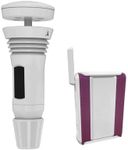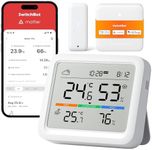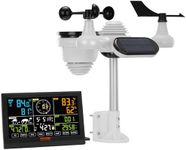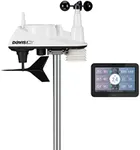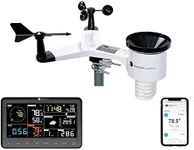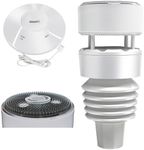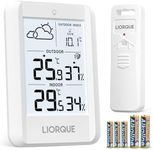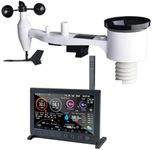Buying Guide for the Best Weather Stations
Choosing the right weather station involves understanding your specific needs and the features that will best serve those needs. Weather stations can provide a wealth of information about the environment around you, from temperature and humidity to wind speed and rainfall. Knowing what you want to monitor and how you plan to use the data can help you make an informed decision. Here are some key specifications to consider when selecting a weather station.SensorsSensors are the components that measure various weather parameters. Common sensors include those for temperature, humidity, wind speed, wind direction, rainfall, and barometric pressure. The importance of sensors lies in their ability to provide accurate and reliable data. If you are interested in basic weather conditions, a station with temperature and humidity sensors may suffice. For more detailed monitoring, look for stations with additional sensors like wind and rain gauges. Your choice should be guided by the type of data you need for your activities, such as gardening, farming, or outdoor sports.
AccuracyAccuracy refers to how close the measurements from the weather station are to the actual conditions. High accuracy is crucial for reliable data, especially if you are using the information for critical applications like agriculture or scientific research. Accuracy can vary between models, with professional-grade stations offering higher precision. For general use, a consumer-grade station with reasonable accuracy should be sufficient. Consider your need for precision when evaluating this spec.
RangeRange is the distance over which the weather station can transmit data from the sensors to the display unit. This is important if you need to place sensors far from the main unit, such as in a large garden or farm. Typical ranges can vary from 100 to 300 feet, with some advanced models offering even greater distances. If you have a large property or need to monitor conditions from a remote location, opt for a station with a longer range. For smaller areas, a shorter range will be adequate.
ConnectivityConnectivity refers to how the weather station communicates with other devices, such as computers, smartphones, or the internet. This can include Wi-Fi, Bluetooth, or wired connections. Connectivity is important for accessing and analyzing data remotely, sharing information, and integrating with other smart home devices. If you want to monitor weather conditions from anywhere or use the data for advanced analysis, look for stations with robust connectivity options. For basic monitoring, simpler connectivity may be sufficient.
DisplayThe display is the interface where you view the weather data collected by the sensors. Displays can range from simple LCD screens to more advanced touchscreens with graphical representations. A clear and easy-to-read display is important for quickly understanding the weather conditions. If you prefer detailed visualizations and ease of use, opt for a station with a high-quality display. For basic needs, a simpler display will work just fine.
DurabilityDurability refers to how well the weather station and its sensors can withstand various environmental conditions, such as rain, wind, and extreme temperatures. This is important for ensuring the longevity and reliability of the station. Durable weather stations are typically made from high-quality materials and are designed to be weather-resistant. If you live in an area with harsh weather conditions, prioritize durability in your choice. For milder climates, standard durability will be adequate.
Ease of InstallationEase of installation refers to how simple it is to set up the weather station and its sensors. This is important for ensuring that you can quickly and effectively start using the station. Some models come with straightforward, user-friendly installation processes, while others may require more technical knowledge. If you are not very tech-savvy, look for a station with easy installation instructions and minimal setup requirements. For those comfortable with technology, more complex installations may not be an issue.

